July 2022 in this area, in line with most of the rest of the UK, was generally very warm (a slight understatement at times!!) , sunny, calm and dry, with just the odd cooler showery day, with no real extremes except a couple of thunderstorms experienced, making it pretty decent for wildlife watching.
Full-day (8 hours) safari bird species day lists dropped a little, down into the 40's or 30's, as some of our wader species moved away from their upland breeding territories to the coasts, and bird-wise things have definitely quietened down , as just about every species seems to have successfully raised and fledged youngsters now, and some will be preparing to leave the area soon...
Mammal day lists varied between 3 and 8, depending on the length of day, and variety of habitats visited...with early starts generally producing more and closer sightings, with again, many species seen with youngsters..
With plenty of sunshine and warmth and the occasional showers, more heather starting to turn a beautiful vivid purple, and the wild flowers and butterflies at their most abundant, the Cairngorms National Park really was a beautiful and unspoilt place to be this month, and my safari clients certainly seemed to enjoy themselves.....
To give you an idea of what you may realistically hope to see if you are considering a future July visit, I hope the following more detailed information, illustrated with photos taken at sites in and around the Cairngorms National Park by myself, my friends or my safari clients this month and in previous July's will help....clicking on the picture enlarges it to full-screen.
I was away for a week mid-month visiting relatives for a 'big' birthday celebration, so my report may be slightly shorter than usual....
Local speciality/upland bird species seen regularly during the month included:
Osprey, Red Grouse, Goldeneye and Dipper. We also enjoyed some decent views of Ring Ouzel early in the month, and Slavonian Grebe, Red-Throated Diver and Black-Throated Diver were all seen occasionally, a few reasonable , if unreliable, views of Crested Tit and Crossbill were managed, and we enjoyed a couple of distant Golden Eagle and White-Tailed Eagle sightings ...Sadly, but typically at this time of year, we failed to see Capercaillie or Black Grouse at all this month....
Mammal species seen regularly included:
Red Squirrel, Rabbit, Brown Hare, Roe Deer, Red Deer, Reindeer and feral Mountain Goat, with just one sighting of a Mountain Hare and one brief glimpse of a Bank Vole ....
July 2022 bird sightings in more detail:
On the lochs...
 |
| A picturesque local loch |
 |
| An adult Osprey with a half-eaten Pike |
 |
| Osprey family by John Rogers |
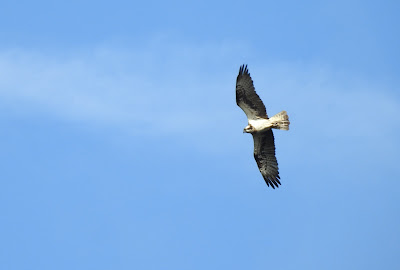 |
| Osprey |
 |
| Young Osprey- Note the 'scaly' plumage and orange eye... |
Our local Ospreys stole the show again this month, these attractive and impressive raptors were often voted as 'Bird of the day' by my safari clients, with the adult birds seen fishing, delivering fish and feeding and encouraging the fast growing 'scaly' looking , orange-eyed youngsters to take their 'maiden flights', and by late-month they had indeed fledged and could be seen perched in adjacent trees and flying for the first time.. I can therefore highly recommend July as THE month for Osprey watching and photography in this area...
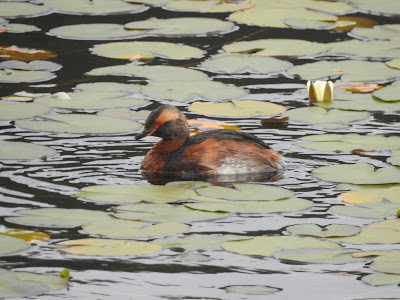 |
| Slavonian (Horned) Grebe |
 |
| Adult and young Slavonian (Horned) Grebe by Bob Smith |
Slavonian Grebe is an increasingly rare UK breeding species, with the few pairs that we do have being confined to northern Scotland, and although most seemed to have bred and departed for the coast , we were lucky to have one local pair lingering.....
 |
| Red-Throated Diver |
 |
| Black-Throated Diver family |
 |
| Black-Throated Diver |
Divers (Loons), being very rare in summer south of here, and looking resplendent in their dapper summer plumage are always popular with my safari clients, and although Red-Throated proved to be a bit elusive, with just a couple of distant sightings, we were fortunate enough to get some good views of Black-Throated through most of the the month on their favoured local lochs, with their 2 rapidly growing youngsters, which is great news. It should be noted however, that they are rarely seen close to the lochside, can be difficult to find in 'choppy' conditions, and are easily disturbed by non wildlife-friendly tourists dog-walking, swimming , fishing and boating etc, so the less windy days and early morning starts in search of them, ahead of the holidaymakers, usually gave us our closest views, and we made sure to savour the moments, as they will soon depart our inland lochs to spend the autumn and winter around the UK coast....
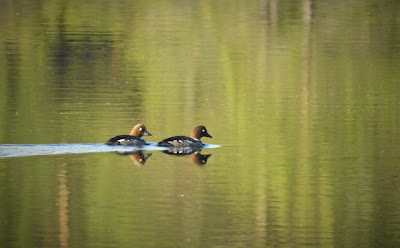 |
| Goldeneyes |
Up on the moors....
 |
| A local upland heather moorland |
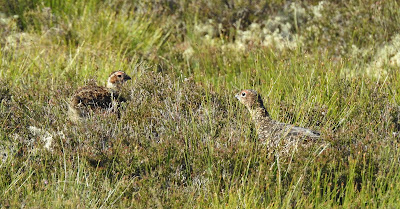 |
| Young Red Grouse with it's watchful mother |
 |
| Adult female Red Grouse |
Red Grouse are always popular with my safari parties, as being a bird of largely uninhabited upland heather moorlands, most of my clients do not have them close to home. We, however, are fortunate to have lots of suitable habitat in this area, and although they were sometimes elusive, we often enjoyed good close up views of families of up to 5 of these very characterful and beautifully marked birds, though with the 'glorious 12th' rapidly approaching... I suspect they may not be quite so obliging next month...
 |
| Short-Eared Owl by John Rogers |
Raptor sightings were a little hard to come by on the moors this month, with just the odd Kestrel, Buzzard and Red Kite being seen, and one decent view of a Short-Eared Owl...
In the Caledonian forests...
 |
| A local Caledonian forest |
 |
| Young Crossbill |
Crossbill sightings were a little tricky to come by this month, with most of them being brief fly-overs, us only identifying them by their characteristic 'jip jip' calls, but thankfully we did manage to get the scope on perched birds on a couple of occasions, though photographic opportunities were very limited...
 |
| Crested Tit |
Crested Tits were seen occasionally on our walks through Caledonian pine forests, usually in family parties, though there didn't appear to be any 'pattern' to our sightings, and I must stress again, that they can be very elusive in the spring and summer months, and knowing their distinctive rippling trills is a huge advantage in helping you to see these very 'flitty' little local specialities....which are incredibly difficult to see or photograph outside of the winter months, and away from feeding stations by the way...
In the birch woods:
 |
| A local birch wood |
A few walks in local birch woods early in the month failed to produce any sightings of Pied Flycatcher or Wood Warbler, though there were plenty of Willow warblers, and various Tits and Finches and a few Spotted Flycatchers, but it was hard work to get decent views or photos, with the trees now in full leaf....
On the rivers...
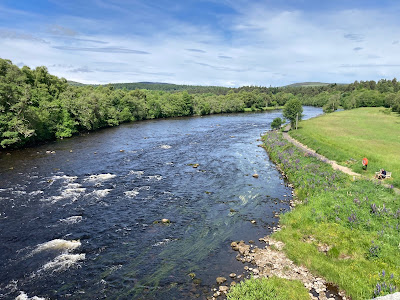 |
| The River Spey |
 |
| Dipper |
Dipper sightings were a bit 'random' this month, with the youngsters fully fledged, the birds were seemingly quite mobile up and down the very low level rivers. On some days, despite our best efforts, we saw none, and on other days we saw one or more on each river we visited! Which just goes to show that although local knowledge and experience are important, nothing is ever guaranteed, and sometimes you need a bit of luck too, as nothing in wildlife can ever be guaranteed...
 |
| Goosander family |
Families of Goosanders and Goldeneyes were also seen on local rivers on a few occasions...
Up in the glens...
 |
| A picturesque local upland glen |
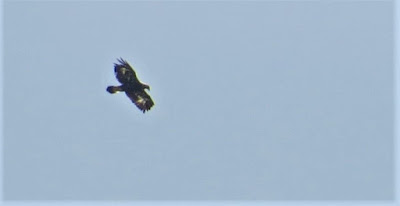 |
| Golden Eagle |
Eagles are probably hardest to see in mid-summer (in this area at least), as the birds are still concentrating on fledging their young, and have so many hours of daylight in which to hunt, and sadly, but true to form, we only managed a couple of distant Golden Eagle and White -Tailed Eagle sightings this month, ......but if previous years are anything to go by, things should improve soon as the youngsters take to the wing for the first time....
Other birds of prey seen reasonably regularly on my safaris this month included Osprey, Common Buzzard, Kestrel, Peregrine, Sparrowhawk and Red Kite.........though a Merlin still eludes me this year!!
Up in the mountains....
 |
| Summer in the Cairngorm Mountains |
 |
| Snow Bunting - Photo from July 2017 |
 |
| Young Dotterel - Photo from July 2017 |
 |
| Ptarmigan family - Photo from July 2019 |
July is 'last chance saloon' for seeing all 3 of our mountain top species ( Ptarmigan, Snow Bunting and Dotterel) in one trip, as the Dotterel often depart in early August , but being pretty busy with safaris, away for a week, and it being so warm, I didn't attempt a mountain top walk myself...so I have included some photos from July in previous years, to show what is possible ....
 |
| Male Ring Ouzel |
At slightly lower levels, but still above 1'500ft, Ring Ouzels were seen in upland habitats near their nesting and feeding areas, at least early in the month anyway, especially near the wetter areas with most worms, but became noticeably more elusive as the month progressed as these areas dried out, and they and their young began to roam even further afield, and it appeared that some may well have already vacated this area and headed south for warmer climes by the end of the month....
On farmland....
 |
| Typical local farmland |
Waders like Oystercatcher, Curlew and Lapwing became noticeably less common on local farmland, as, with breeding now completed, they began to migrate back to the coasts for autumn and winter, leaving Red-Legged Partridge and Common Pheasant as the main attractions...
Other good/scarce birds seen/reported locally this month included:
A long-Tailed Skua was reported at Insh Marshes early in the month, but it was a pretty quiet month for rarities in this area....
A few photos of more common birds seen locally this month:
 |
| A young Jackdaw |
 |
| Meadow Pipit |
 |
| Male Bullfinch by John Rogers |
 |
| Spotted Flycatcher |
 |
| Common Sandpiper by John Rogers |
 |
| A very rare daytime photo of a Woodcock |
Adventures 'out of area':
Being quite busy with safaris, and away for a week, I didn't have any opportunities to venture far this month...though it should be noted that July is of course the last month to visit coastal seabird colonies to see all the auk species (Puffin, Razorbill, Guillemot etc), before they head back out to sea in August...
July 2022 mammal sightings in more detail:
 |
| Red Squirrel |
 |
| Red Squirrel |
Red Squirrel was probably voted 'mammal of the day' most frequently by my safari clients this month, with many of them excited to see these charismatic and undeniably cute little animals for the first time, and bringing home to me the fact that, although I am lucky to see them regularly here, they are now very difficult to see in most of the UK, being confined mainly to the northern Scottish Highlands, with just a few small localised populations remaining in other areas...
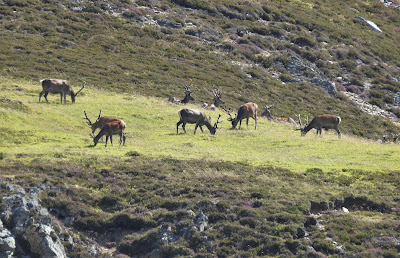 |
| Red Deer stags |
 |
| Red Deer hinds with their young |
Similarly, another iconic 'Highland speciality', Red Deer were seen regularly in local upland glens, usually in large same-sex herds, the stags happily feeding and seemingly relaxing, and the hinds with their fast-growing young always nearby ....
 |
| Feral Mountain Goats |
We also have feral Mountain Goat locally....interesting animals, that seem to like remote upland areas, and come in a wide variety of colours, from white, through grey and brown to black, or sometimes a mixture of all of these...
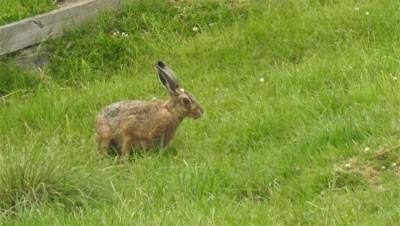 |
| Brown Hare |
The same could also be said of Brown Hares, with most of our sightings coming early in the day before too much human disturbance, and generally on the more remote and secluded areas of open farmland...
Mountain Hares too are actually pretty tricky to find, certainly outside of the winter months, especially in their 'summer camouflage' coats of mottled brown and grey, and the few sightings that we did manage this month were brief 'random' encounters on mountainsides or high moorlands, whilst in search of the special birds of those habitats, with no chance of a photo opportunity.
 |
| Carrot time for Murdo |
Hairy Highland Coo's always prove to be popular with my safari clients, especially those who do not have them close to home, so don't be afraid to ask me if you fancy going to see them, and maybe even get to feed and 'pat' them, as I have a couple of great sites....
Rare/nocturnal mammals:
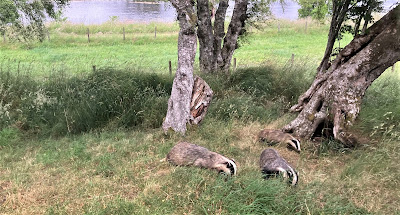 |
| Badgers - Viewed from a local dusk hide |
I get a few enquiries about the possibility of seeing Badgers and Pine Marten from my safari clients, many of whom I suspect are unaware that they are actually a largely nocturnal creature, and although we do get the occasional (maybe one or two a year) dawn glimpse of one, you would definitely have a much higher chance of seeing them at a specific dusk Badger/Pine Marten watching hide - Please contact me for more information.
Similarly, our inland Otters too are mainly active during the hours of darkness, and again, although we do get a few early-morning sightings on local lochs and rivers each year, looking for them feeding in a suitably quiet, kelp - filled bay on the coast on a rising tide, but at any time of day, would give you a much better chance.
Whilst we are still on the 'tricky to see stuff', the Scottish Wildcat too, as well as being incredibly rare now, is also generally nocturnal, and the fact that I have had a mere handful of (dawn or dusk) sightings in 18 years of providing wildlife safaris should give you an idea of how difficult they are to see.
Other wildlife:
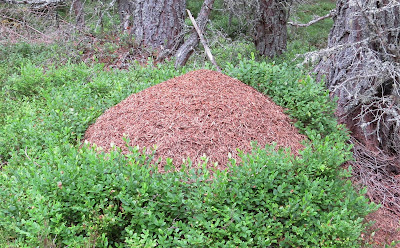 |
| Wood Ant nest |
The warm weather of July usually sees our local Wood Ants at their most active...
 |
| Common Blue |
 |
| Small Pearl-Bordered Fritillary by Bob Smith |
 |
| Small Tortoiseshell |
 |
| Scotch Argus |
Butterflies of many different types were seen regularly, on the calmer sunnier days at least, with the more common species now being joined by our 'local speciality' the Scotch Argus towards the end of the month...
 |
| Leaping Atlantic Salmon |
The occasional rainfall and corresponding rises in water levels allowed the Atlantic Salmon to make their way a little further up our local rivers, and visits to popular local falls and 'leaps' can give great views - and for those with LOTS of patience, even the odd photo opportunity, as these amazing creatures attempted to fight the powerful flows and often steep ascents, to return upstream to their birthplace breeding grounds to reproduce...a highly recommended wildlife experience....
 |
| Rosebay Willowherb in full bloom at a local loch |
News:
I am very pleased to announce that Highland Wildlife & Birdwatch Safaris has recently been awarded a Travelers Choice accreditation from Trip Advisor, for being ranked n the top 10% of visitor attractions worldwide based on customer reviews and feedback.
This achievement would not have been possible without the support of all
my family, friends, safari clients, social media followers, regular blog
readers and everyone else who has helped and encouraged me along the way to
‘living my dream’ of being a wildlife safari guide, since 2004, especially over
the last couple of very difficult years, so a big THANK YOU to you all :)
All tourism/hospitality/activities in Scotland are open , are now free of restrictions and that I have now completed well over a year of (thankfully!) increasingly busy and extremely enjoyable safaris with clients with no major issues arising.
With all national travel restrictions lifted too, Scotland is officially 'open for business' for visitors from all over the UK, and from abroad.
For those considering a visit, these wildlife/outdoor tourism websites may prove useful:
https://www.gov.scot/collections/coronavirus-covid
NatureScot (outdooraccess-scotland.scot)
Can Nature Help Health? | Nature Prescriptions - YouTube
Scotland, Yours to Enjoy. Responsibly. - YouTube
Cairngorms National Park Authority
 |
| The upper reaches of the River Spey |
Summary:
Although the bird breeding season is almost over, July is still a pretty decent month to see a good selection of birds, animals and butterflies in this area, with no need for a really early start, and it's also good for a mountain-top adventure, or a trip to a seabird colony with (usually) fairly good weather, and all still with plenty of daylight hours....
I must confess though, that I always tend to feel just a little sad at the end of every July , as I know that many of our iconic summer visiting birds like Osprey, Slavonian Grebe, Ring Ouzel and the Divers, are soon to vacate our area and fly south to warmer climes as summer turns to early autumn next month.....
Reviews:
https://www.tripadvisor.co.uk/Attraction_Review-g186537-d3335134-Reviews-
Buying my photos:
Prints of any of the photos (taken by myself) shown on this blog, going right back to 2015, reproduced on high quality photographic paper, with a choice of sizes up to A3, and satin pearl or glossy finishes available, can now be purchased from me at very reasonable prices. So if you see an image that might look nice in a frame (provided by yourself) on your wall, please make a note of the year and month of my blog in which it appeared, and email me for more information.
| Safari gift voucher |









